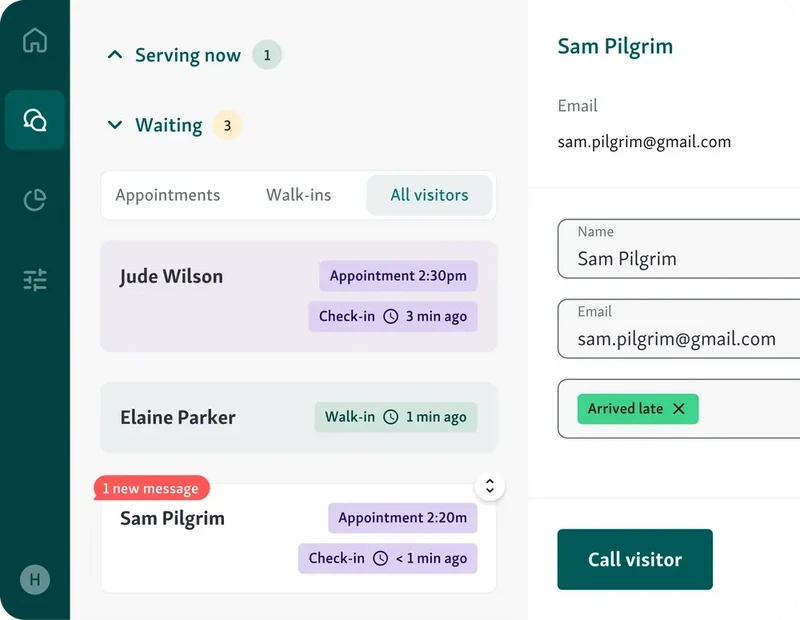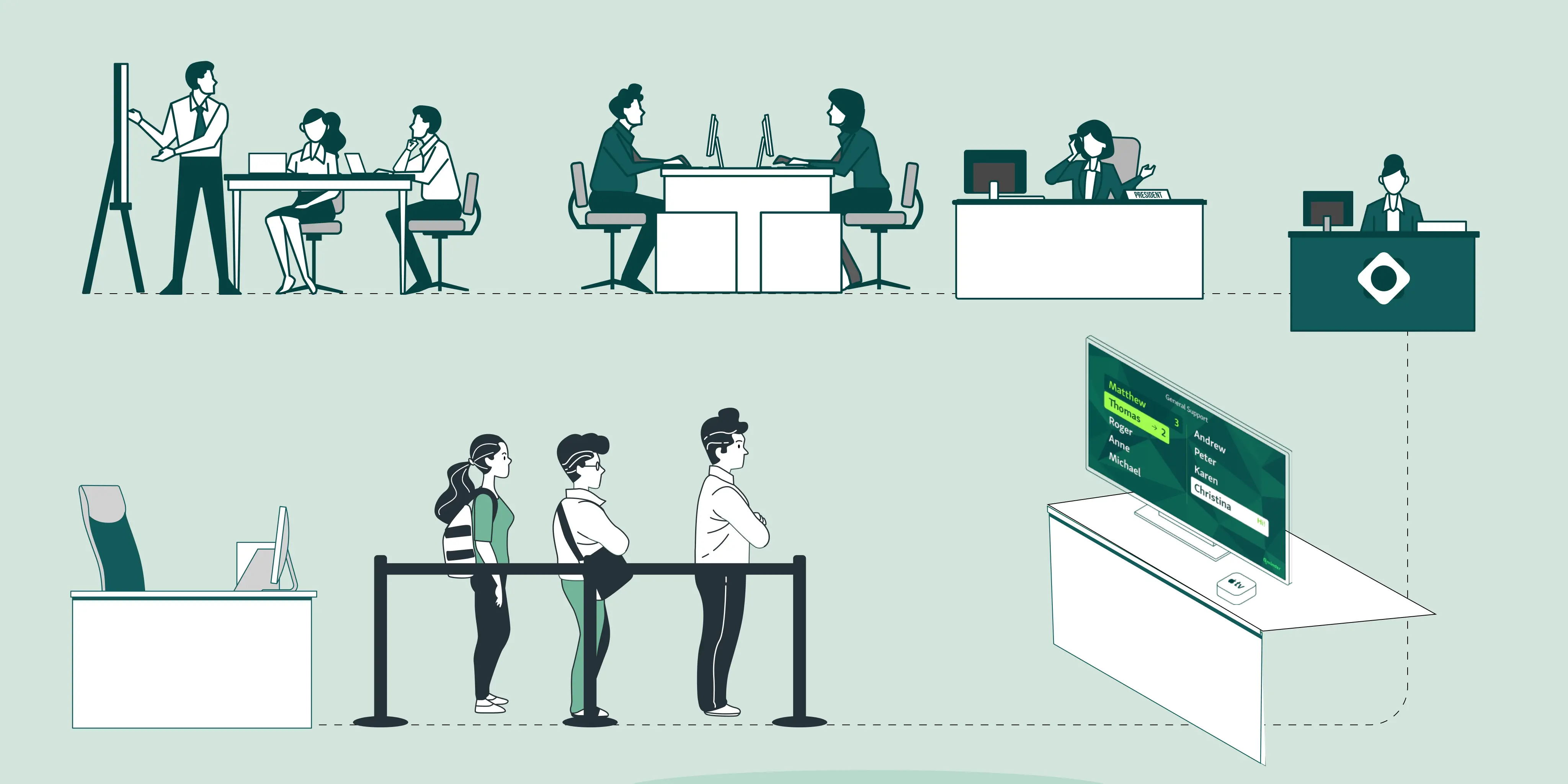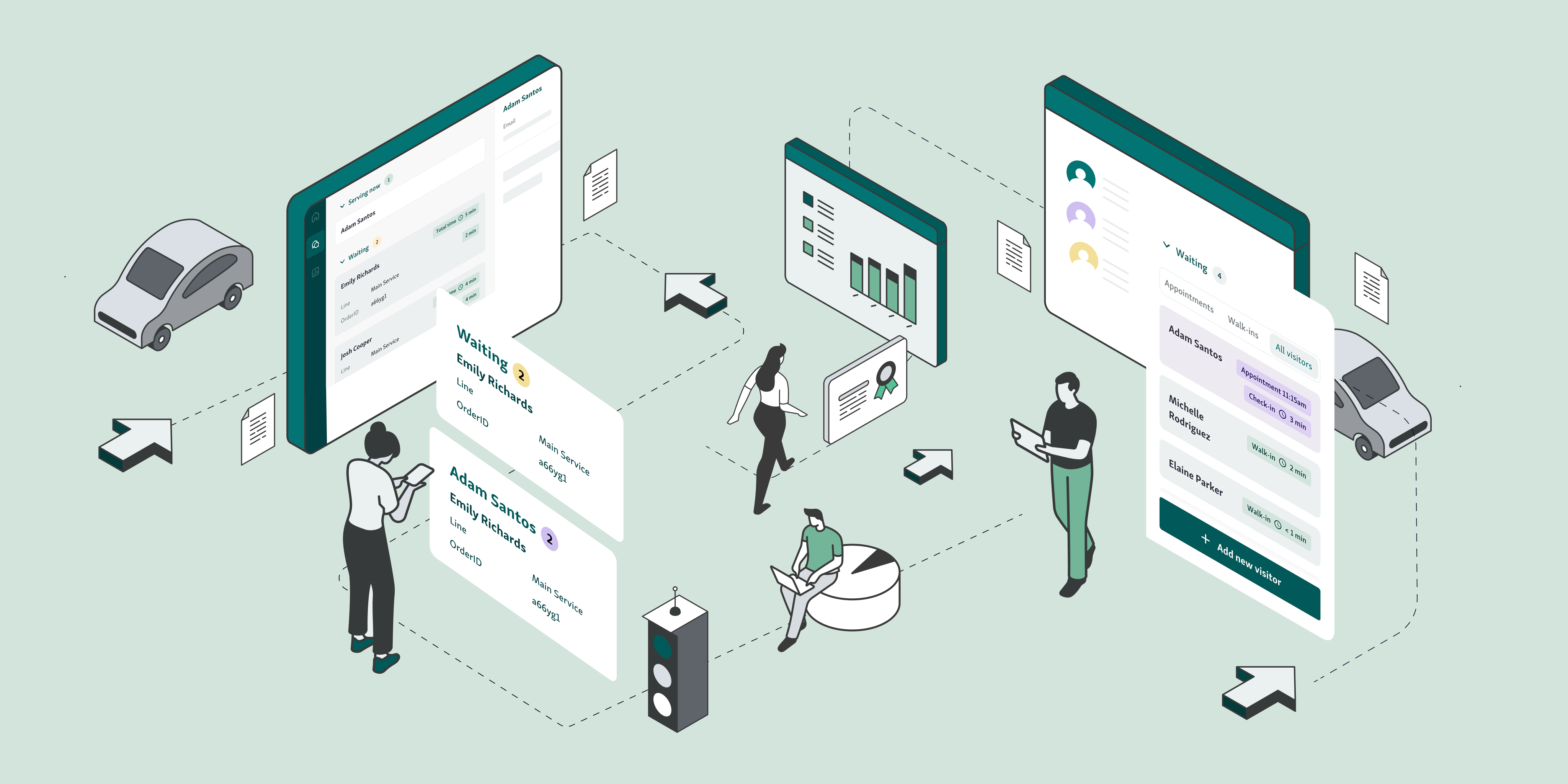Long lines and unclear processes at government offices have frustrated citizens for years.
From renewing licenses to accessing social services, the experience is often marked by delays and crowded lobbies. These inefficiencies not only waste time but also strain staff and weaken public trust.
Citizens now expect streamlined services, and modern scheduling systems meet this demand by cutting wait times and improving communication.
For instance, a study found that implementing advanced access scheduling in the Veterans Affairs (VA) system reduced the average wait time for appointments from 42.9 days to 15.7 days, demonstrating the significant impact of such systems on service delivery.
In this blog, we’ll explore how appointment scheduling systems reduce wait times, improve communication, and elevate the overall experience in government services.
The Problem with Walk-In Only Systems
Relying solely on walk-ins might seem like a low-maintenance approach, but it often results in unnecessary stress and inefficiency, for both citizens and staff.
No predictability means longer waits: Without scheduled time slots, visitors have no way of knowing how busy the office will be. This often leads to long, uncomfortable waits in crowded lobbies, eroding public satisfaction.
Inconsistent arrival times create bottlenecks: Some people show up too early in hopes of beating the rush, while others arrive much later than they should. This uneven flow causes spikes in demand and idle periods, making it hard to maintain a steady pace.
Staff can’t plan effectively: Without insight into how many people will show up or when, employees struggle to allocate resources or breaks. This results in overworked staff during peak hours and underutilized time during lulls.
In short, walk-in-only systems leave everyone, citizens and staff alike—operating in the dark.
Helpful read - Walk-in vs. Appointment Scheduling: Choosing the Best Approach
Key Ways Appointment Scheduling Improves Customer Experience
Let’s look at how appointment scheduling systems reduce wait times, improve transparency, and provide flexibility, creating a smoother experience for both citizens and staff.
1. Reduces Waiting Time
Long, uncertain waits are one of the biggest frustrations citizens face in government offices. Walk-in systems often result in overcrowded lobbies and unpredictable service patterns, making the entire experience stressful for both visitors and staff.
Appointment scheduling solves this by pacing arrivals, spreading foot traffic evenly across the day, and helping people plan their time better.

Citizens know exactly when to arrive.
Office traffic is more evenly distributed.
Staff can focus on one visitor at a time without feeling rushed.
Lobbies stay calmer and less crowded.
Visitors waste less time waiting around.
With tools like Qminder, government offices can offer appointment slots online, send reminders, and keep citizens informed about any delays or changes—leading to a smoother, more respectful service experience.
Example: Take a DMV branch. Instead of showing up at 8 a.m. with 30 others and waiting for hours, a citizen can book a 10:30 a.m. time slot online the night before. When they arrive, they check in via their phone and are seen within minutes—no chaos, no guesswork. Staff also benefit from a steady flow rather than a morning rush, making the day more manageable.
2. Enhances Transparency
One of the most common pain points for citizens visiting government offices is the uncertainty surrounding wait times and service delays. With walk-in systems, it's often unclear when someone will be seen, leading to frustration and confusion.
Appointment scheduling provides transparency by giving citizens clear information on what to expect, both in terms of timing and service availability. This leads to a better experience by keeping individuals informed every step of the way.
Citizens know exactly when to expect service.
No more guessing about wait times or delays.
Real-time updates reduce anxiety and frustration.
Staff can better manage expectations with accurate scheduling.
Visitors are kept in the loop with alerts or notifications.
With appointment queue software, government offices can offer real-time wait time updates via SMS or an online portal, giving citizens a clear picture of their status in the queue.

Example: A person visiting the local courthouse to file paperwork. Instead of waiting without knowing when they’ll be called, they receive SMS updates with estimated wait times. If the wait extends due to delays, they're promptly notified, allowing them to decide whether to stay or come back later, keeping everyone informed and more at ease.
3. Enables Better Planning
Appointment scheduling offers a level of flexibility that walk-in systems simply can’t. Citizens can choose a time that fits their schedules, whether it's for a routine service, renewal, or application.
This level of planning is especially helpful for those with busy lives, mobility issues, or other personal constraints. Instead of having to spend hours waiting in line, they can plan their visit around other important commitments, making the process smoother and more convenient.
Citizens can select the most convenient time for their visit.
Reduces the chance of missed appointments or long delays.
Helps citizens with special needs or mobility issues plan more effectively.
Flexible scheduling improves overall satisfaction.
Encourages better attendance and reduces no-shows.
With Qminder, citizens can book their appointments online or via mobile, allowing them to choose the most opportune time for their visit based on their preferences and availability.
Example: A senior citizen needing to renew a driver’s license can choose an appointment time that aligns with their caregiver’s availability, ensuring they don’t have to wait for long periods. The ability to plan ahead makes the visit more comfortable and less stressful for everyone involved.
4. Improves Accessibility for All
An effective appointment scheduling system makes services more accessible by offering multilingual support and user-friendly interfaces. Government offices serve a diverse population, and providing language options ensures non-native speakers can easily navigate the booking process.
Additionally, ADA-compliant interfaces and clear user flows help those with disabilities, making it possible for everyone to book appointments independently. Accessibility ensures that every citizen, regardless of language or ability, has an equal opportunity to access the services they need.
Multilingual support caters to citizens who speak different languages.
ADA-compliant interfaces enhance accessibility for those with disabilities.
Clear and intuitive navigation helps users of all abilities.
Citizens feel included, leading to a more positive experience.
Accessibility improvements reduce confusion and enhance engagement.
With appointment queue software, government offices can integrate multilingual options and ADA-compliant interfaces, ensuring that all visitors, regardless of language or physical limitations, can use the system effectively.
Example: A family who speaks Spanish can easily book an appointment for their child’s vaccination, using the system’s Spanish-language interface. Additionally, a citizen with visual impairments can navigate the system with the screen reader-friendly design, ensuring an inclusive and seamless experience.
5. Minimizes No-Shows and Missed Appointments
One of the biggest challenges for government offices is managing no-shows and last-minute cancellations, which can disrupt service flow. Appointment scheduling systems address this by sending automated reminders via SMS or email, ensuring citizens don’t forget their appointments.
On top of that, the ability to easily cancel or reschedule appointments provides flexibility for citizens, allowing them to adjust their commitments without hassle. These features reduce missed appointments, increase attendance, and make the process more efficient for both citizens and government staff.
Automated reminders via SMS or email reduce the chance of missed appointments.
Easy cancellation and rescheduling provide flexibility for citizens.
Reduces gaps in appointment schedules, optimizing staff time.
Improves overall office efficiency and customer satisfaction.
Encourages responsible behavior from citizens by making the process simpler.

Qminder helps minimize no-shows with automated reminders and easy rescheduling options. Citizens are more likely to keep their appointments when they receive timely reminders and can quickly adjust their plans if needed.
Example: A citizen who has a scheduled appointment at the DMV receives an SMS reminder 24 hours before. If they need to reschedule, they can easily do so via the system without calling, ensuring they don’t miss their appointment and keeping the office’s workflow running smoothly.
6. Less Stress on Staff
Handling unpredictable foot traffic and long queues can be exhausting for government staff. Appointment scheduling systems ease this burden by spreading out visitor traffic more evenly throughout the day.
With predictable visitor numbers at specific times, staff can focus more on delivering quality service rather than managing overcrowded lobbies and frustrated visitors. This reduces stress, enhances the overall work environment, and leads to better service delivery.
Spreads out visitor traffic, reducing peak-time congestion.
Allows staff to prepare and manage workloads more effectively.
Reduces stress caused by overcrowding and long queues.
Enhances staff productivity and service quality.
Creates a more organized and calm work environment for employees.
Qminder helps level out visitor traffic by allowing citizens to book appointments in advance, making it easier for staff to anticipate visitor volume. This means employees can focus on providing better service and avoid the chaos of walk-ins.
Example: A government office dealing with social services finds that having scheduled appointments prevents a rush of visitors at opening hours. With more manageable visitor flow, staff can dedicate their time to offering personalized services, improving overall efficiency and reducing employee burnout.
Real-World Example: Using Qminder in Government Offices
See how government offices are using Qminder to streamline operations, reduce wait times, and deliver better service to citizens.
1. City of Manhattan Beach Moves to Digital Queue Management
The Problem: Paper-Based Check-Ins and Staff Overload
At the City Hall of Manhattan Beach, visitor traffic was managed using pen-and-paper sign-in sheets. This outdated system was time-consuming for staff, prone to errors, and frustrating for residents who had to wait in unclear, unmanaged queues. With nearly 4 million annual visitors, the pressure on city services was growing—leading to inefficiencies and long wait times.
The Solution: Testing and Selecting the Right System
To modernize their process, the city tested multiple queue management systems during free trials, comparing them based on ease of use, integration, and cost. Qminder stood out for its simplicity and user-friendliness. The city developed a plan to implement self-check-in via iPads, real-time queue displays, and dedicated staff dashboards. This digital approach would streamline visitor flow and improve clarity for everyone involved.
Impact: A More Organized, Citizen-Centric Experience
Though full implementation is still in progress, early results are promising.
Qminder’s analytics already help the city plan staffing around visitor patterns.
Citizens will gain transparency into wait times and queue positions.
Staff are expected to spend less time managing lines and more on helping people.
The new system brings local government in line with the expectations set by modern, digital-first services.
2. How Greensboro Modernized Walk-In Management with Qminder
The Challenge
Before Qminder, Greensboro’s walk-in process relied on manual sign-ins and receptionist directions. This led to congestion, long waits, and limited ability to adapt during the COVID-19 pandemic, which demanded contactless service and safer visitor handling.
The Solution
Greensboro introduced Qminder’s digital check-in system using lobby kiosks. Visitors enter basic info, receive a text with forms to complete remotely, and see their queue status on a screen. Staff get real-time access to visitor data, allowing smoother, faster service without unnecessary contact.
The Impact
Qminder helped Greensboro cut down wait times and improve visitor communication. Employees now focus more on service and less on managing lines. What began as a pandemic necessity has turned into a lasting improvement in how the city serves its citizens.
Wait times are now close to zero thanks to efficient sign-in flow.
Visitors receive timely updates and can complete forms on their phones.
Staff no longer chase down customers or manually manage queues.
The process is now safer, touchless, and more transparent for everyone.
Bring Efficiency and Transparency to Public Service
Modernizing government services doesn’t have to be complicated. Appointment scheduling systems are a practical, high-impact solution that improves how citizens experience public services, from shorter wait times to greater accessibility and reduced stress for staff.
With tools like Qminder, agencies gain more than just a way to book appointments. These tools offer real-time service visibility, smarter resource planning, and a seamless flow of communication with visitors. It's a simple shift that leads to a significant boost in public satisfaction and internal efficiency.
If your goal is to create a more organized, citizen-friendly experience, investing in the right appointment system is a smart place to start.
Try Qminder for free and see the difference it can make for your office.
Systems like Qminder support on-site sign-in kiosks, allowing citizens to check in easily without needing personal devices.
Minimal training is needed. Most systems are intuitive and come with onboarding support to get teams up and running quickly.
Reputable platforms like Qminder follow strict data protection standards, ensuring all citizen information is stored securely and complies with privacy regulations.




